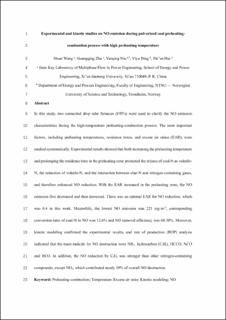Experimental and kinetic studies on NO emission during pulverized coal preheating-combustion process with high preheating temperature
| dc.contributor.author | Wang, Shuai | |
| dc.contributor.author | Zhu, Guangqing | |
| dc.contributor.author | Niu, Yanqing | |
| dc.contributor.author | Ding, Yiyu | |
| dc.contributor.author | Hui, Shi'en | |
| dc.date.accessioned | 2021-10-21T12:35:35Z | |
| dc.date.available | 2021-10-21T12:35:35Z | |
| dc.date.created | 2021-05-17T20:36:46Z | |
| dc.date.issued | 2021 | |
| dc.identifier.issn | 0144-2600 | |
| dc.identifier.uri | https://hdl.handle.net/11250/2824528 | |
| dc.description.abstract | In this study, two connected drop tube furnaces (DTFs) were used to clarify the NO emission characteristics during the high-temperature preheating-combustion process. The most important factors, including preheating temperatures, residence times, and excess air ratios (EAR), were studied systematically. Experimental results showed that both increasing the preheating temperature and prolonging the residence time in the preheating zone promoted the release of coal-N as volatile-N, the reduction of volatile-N, and the interaction between char-N and nitrogen-containing gases, and therefore enhanced NO reduction. With the EAR increased in the preheating zone, the NO emission first decreased and then increased. There was an optimal EAR for NO reduction, which was 0.4 in this work. Meanwhile, the lowest NO emission was 223 mg·m−3, corresponding conversion ratio of coal-N to NO was 12.6% and NO removal efficiency was 60.38%. Moreover, kinetic modeling confirmed the experimental results, and rate of production (ROP) analysis indicated that the main radicals for NO destruction were NH2, hydrocarbon (CiHj), HCCO, NCO and HCO. In addition, the NO reduction by CiHj was stronger than other nitrogen-containing compounds, except NH2, which contributed nearly 30% of overall NO destruction. | en_US |
| dc.language.iso | eng | en_US |
| dc.publisher | Elsevier | en_US |
| dc.rights | Attribution-NonCommercial-NoDerivatives 4.0 Internasjonal | * |
| dc.rights.uri | http://creativecommons.org/licenses/by-nc-nd/4.0/deed.no | * |
| dc.title | Experimental and kinetic studies on NO emission during pulverized coal preheating-combustion process with high preheating temperature | en_US |
| dc.type | Peer reviewed | en_US |
| dc.type | Journal article | en_US |
| dc.description.version | acceptedVersion | en_US |
| dc.source.journal | Journal of the Institute of Energy | en_US |
| dc.identifier.doi | https://doi.org/10.1016/j.joei.2021.04.016 | |
| dc.identifier.cristin | 1910359 | |
| dc.description.localcode | This is the authors' accepted manuscript to an article published by Elsevier. Locked until 6.5.2023 due to copyright restrictions. The AAM is made available under the CC-BY-NC-ND 4.0 license http://creativecommons.org/licenses/by-nc-nd/4.0/ | en_US |
| cristin.ispublished | true | |
| cristin.fulltext | postprint | |
| cristin.qualitycode | 1 |

